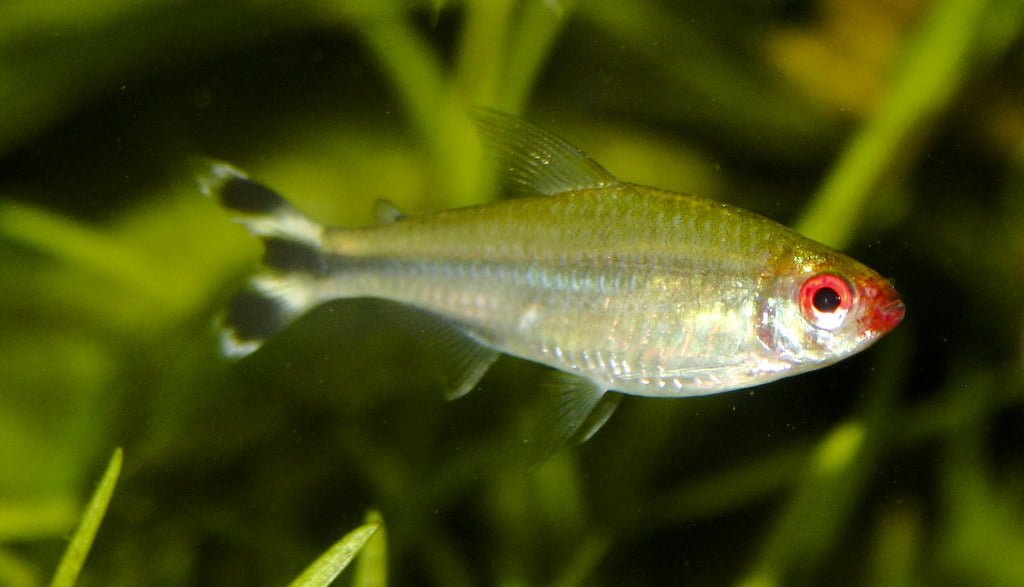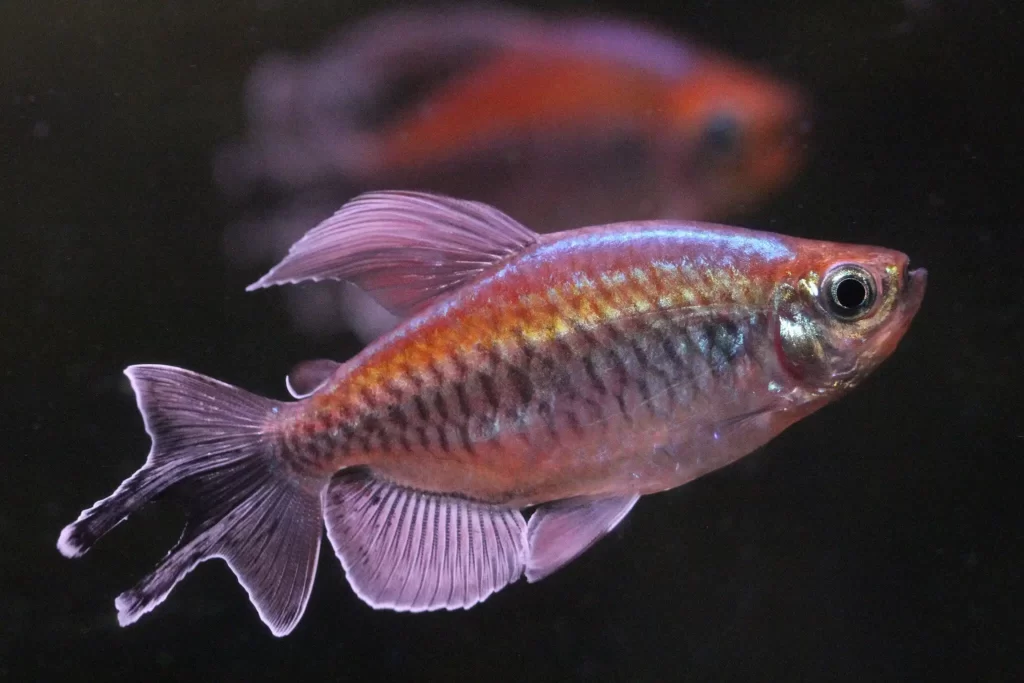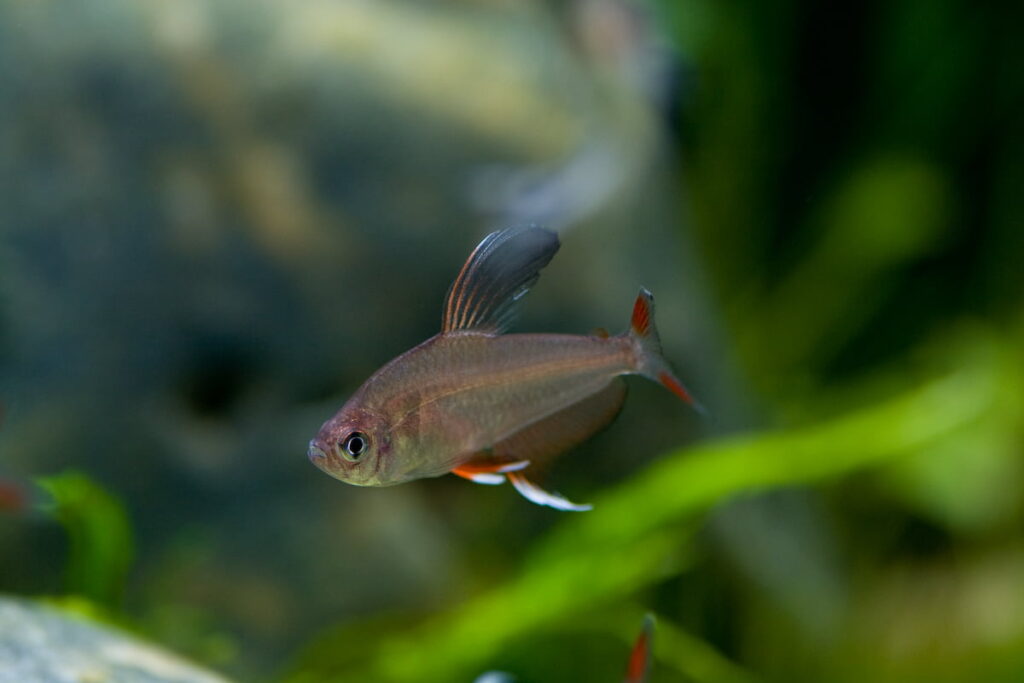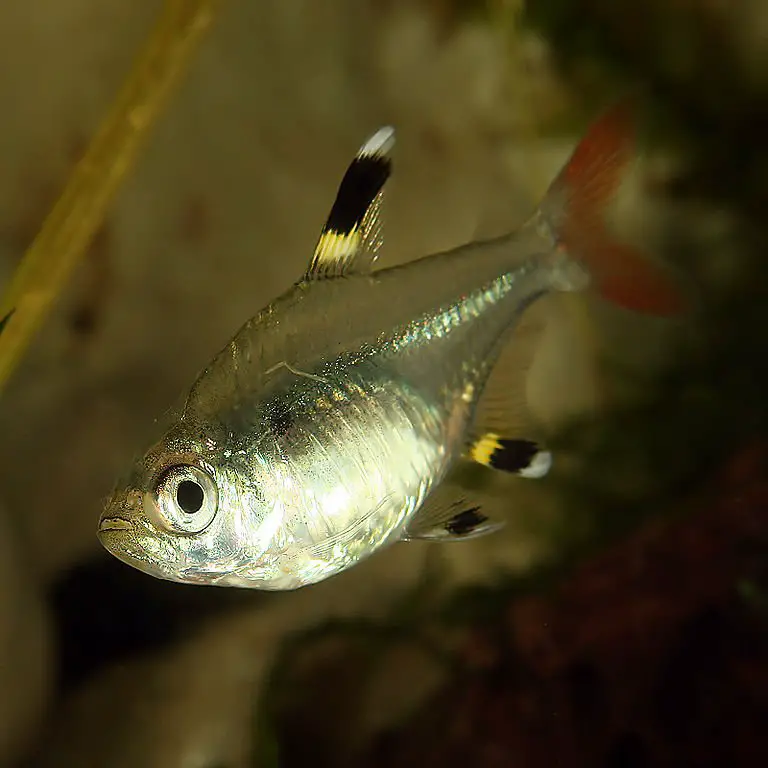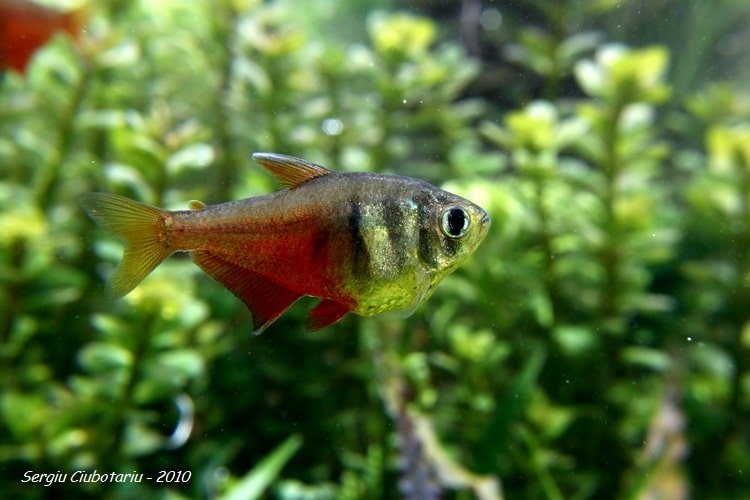Rummy Nose Tetra (Scientific Name: Hemigrammus Bleheri) is a beautiful fish of the Tetra family. The fish has an incredibly unique feature; it has a bright red spot on its head; this the reason Rummy Nose Tetra is also called Fire Tip Tetra. Other than that, its fluke has black and white stripes, and the body is silvery.
Rummy Nose Tetra is unquestionably beautiful fish and surprisingly very easy to care too. They are easy to feed and accept a wide range of water parameters. However, a little experience is needed to make sure they live healthily in your aquarium.
Rummy Nose Tetras are schooling fish that are a bit bigger as compared to other fish in the tetra family. They need to be kept in a group of at least six pairs, and as they are comparatively bigger tetras, they need a larger tank.
In this article, we will be discussing everything you need to know about Rummy Nose Tetra. From its Description to tank setup and ho to breed them.
Let’s Get Started.
Origin and Habitat in the Wild
Rummy Nose Tetra are freshwater fish from the Characidae family that comes from the river Rio-Vaupes, Columbia, and the Rui Negro River in Brazil. Rummy Nose Tetras also inhabits Amazon river tributaries sharing its room with other tetras and non-aggressive fish.
The fish was described first by Géry and Mahnert in 1986.
These tetras live in very acidic water. The acidity is due to decayed plants and organic matter found at the bottom of the lake.
In the wild, they prefer to live and swim in the middle and bottom of the river, feeding insects, plant matter, larvae, algae, and anything that fits in their tiny mouth.
Distribution
The Hemigrammus bleheri is very similar to two of its cousins. The banded Rummy Nose Tetra (Hemigrammus rhodostomus), also known as true Rummy Nose Tetra and Black fined Rummy Nose Tetra (Petitella Georgia) also known as False Rummy Nose Tetra.
All these breeds are native to South American water. However, each species occupies a different region. But the care they require is very much alike.
Characteristics
Scientific name: Hemigrammus Bleheri
Common Name: Brilliant Rummy Nose Tetra, Firehead Tetra, Red Nose Tetra
Family: Characin
Behavior: Peaceful and Active
Lifespan: 5 to 6 years (if cared properly)
Color: Silvery Body with red marking on the head with a zebra pattern on the tail.
Diet: Omnivores (can eat both plant and live food)
Environment: Freshwater
Maximum size: 2.5 inches
Group Behavior: School
Age of Sexual Maturity: 5 – 8 months
Experience Level: Beginners who have a little knowledge about fish
Breeding: Normal, Egg Layer
Temperature: 24C to 28C / 72 to 82F
pH value: 6.0 to 8.0
Hardness condition: 2 to 15dGH (recommended)
Tank size: 20 Gallon
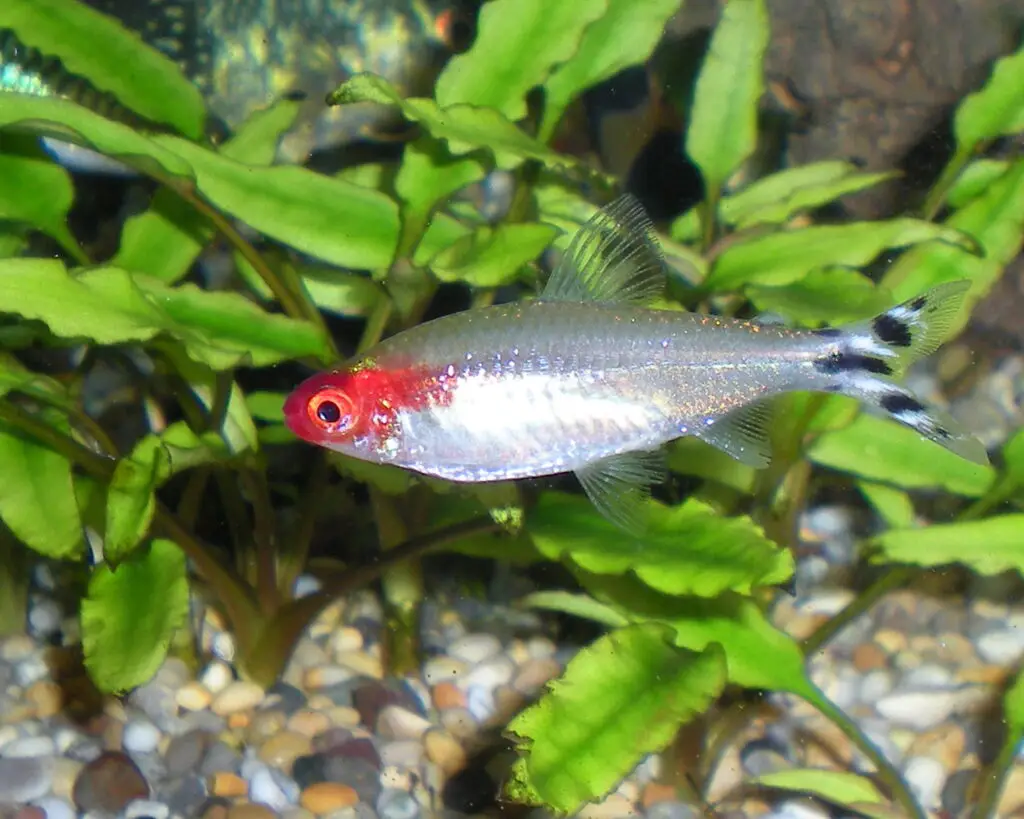
About Rummy Nose Tetra
Rummy Nose Tetra is a full-bodied, large tetra species that reach about 1.75 inches in length. These fish are very popular among beginner aquarists due to their distinctive coloration.
The fish has a bright red mark on its head from which it got its name Fire Tip Tetra. The silvery body even pops up the red marking on its head and has black and white on its tail fins.
Let’s learn about the fish in detail.
Appearance
Rummy Nose Tetra are popular because of their striking colors and markings across its body.
Their body is semi-transparent with plain silver in most of the parts. Their head is covered with deep red color, which gives them their name “Fire head tetra / Rummy Nose Tetra.” Their flesh fins and fluke stand out just as much as the head with a zebra-like design of black and white stripes. The rest of the fins are translucent.
When the fish is stressed, the red marking on its head gets pale significantly; the sign that your fish is having some trouble in your tank.
Rummy Nose Tetras are big tetra as compared to other fish in the tetra family. They get up to 1.75-2 inches (5 centimeters) and has a lifespan of about 5 to 6 years in captivity.
Availability
The Rummy Nose Tetra is readily available worldwide. Since the fish is not even evaluated in the IUCN Red List, there isn’t any restriction to house them or trade them.
And as Brilliant Rummy Nose Tetra H. Bleheri has a superior color, which extends from its nose to beyond the gills. Due to this characteristic, the Brilliant Rummy Nose Tetra is the primary species of Rummy Nose that are found in the pet store.
Price
Rummy Nose Tetra is very affordable to buy and is suitable for people or beginners who do not want to spend a lot of money. A pair of Rummy Nose Tetra Cost Around $2.99 for a pair as you need to keep them in a group of at least 10, you will be spending about $25 to $30.
The lifespan of Rummy Nose Tetra
In the wild, Rummy Nose Tetra lives typically for around eight years. However, in captivity, they generally have a lifespan of about 5 to 6 years.
Maintain your aquarium condition so that they can live their entire life happily in your aquarium.
Sexual differences
The problem with Rummy Nose Tetra is that they are hard to determine whether they are male or female.
Only a fish specialist can distinguish the fish at his first glance. However, one thing that separates the sexes of Rummy Nose Tetra is its belly. As female Rummy Nose Tetra carries the eggs during spawning, their belly as a bot rounded as compared to males. Likewise, another difference is that female Rummy Nose Tetra as a bit bigger as compared to the males.
Fishkeeping Difficulty
Rummy Nose Tetra is a bit difficult to keep. You need to have some fish keeping experience or the basic knowledge about its requirements to keep this tetra. The fish is highly sensitive to its water parameter; any sudden change in water quality can severely affect your Rummy Nose Tetra. The most common Disease is ich.
If you provide them with the right water parameter, they are very adaptable and can do well without a heater in well-insulated homes.
Social Behavior of Rummy Nose Tetra
Rummy Nose Tetra are schooling fish; they spend most of the time in a group that creates an impressive display as little light signs through their body. The colors in their body are more striking and beautiful and majestic when they swim together.
Rummy Nose Tetras are peaceful creatures of nature. They are shy and won’t dominate other fish.
Rummy Nose Tetra is a comparatively big fish among other tetras and requires much larger space. They should not be kept alone in an aquarium as they are fearful of fish. They get frightened when left alone. You might see them hiding among the plants if they get stressed or frightened. Don’t be tempted to overstock your tank, though!
They need to have plenty of free space to swim freely. And spend most of their time swimming in the middle level of your tank. Buying a bigger tank is always a good idea as it is suitable for your fish and requires lesser maintenance.
Caring For Rummy Nose Tetras
Taking care of Rummy Nose Tetra is not that difficult when you fulfill all the requirements it needs. A decent size tank, good aquarium water, temperature, tankmates, a proper diet is all a fish needs to be happy.
No matter what fish you pet, how hardy it is, you still need some sort of maintenance and care for them to thrive and live happily in your tank. And in the case of Rummy Nose Tetra, they are very sensitive animals that require proper care.
We will be discussing the care that Rummy Nose Tetra requires in this section of the article. So keep reading so that your fish will be happy their entire life in your aquarium.
Tank size
Rummy Nose Tetras are schooling fish that are quite active. They keep on moving around your aquarium for hours. Since they need to be kept in a group and are an active fish, they require a bigger tank.
Most beginner fish keepers make a mistake while choosing an aquarium. They buy a small aquarium since it’s their first aquarium and tries to fill it up with various fish they find attractive in the market. And eventually, they see dead fish floating around their tank surface in a few days or weeks. So, tank size is the most crucial factor in fish keeping hobby.
One inch of your fish requires two gallons of water. So, to house 10 Rummy Nose Tetras, you will need a 30 to 40 Gallon fish tank.
A bigger tank is always better in terms of maintaining the aquarium water. They are easy to clean, has a lot of room for the fish to play and can equip aquarium equipment like filter heaters, thermometer, etc. with ease.
If you are planning to create a community tank adding a variety of fish, go for an even bigger tank like the 75-gallon fish tank. This will ensure all the fish living in it are happy. However, do not overstock your fish tank.
Lightings in aquarium
Rummy Nose Tetra comes from areas that are covered with dense forests where very little light gets in through the water. So, do not use any bright lightings in your aquarium unless your aquarium is densely planted with live plants. Bright lights tend to stress out Rummy Nose Tetra. Light in your aquarium should be moderate to normal as possible.
Water quality
Although Rummy Nose Tetras are hardy fish that can adapt to a wide range of water parameters, they are still sensitive to water parameters. Like, their color fades away as the temperature drop pollutants increases in your tank. Yes, they can thrive in various water parameters, but its best to provide them with what they require.
Its always better to get a big tank and add live plants in your aquarium. This will ensure that the water in the tank is maintained to its optimum.
Water temperature
Rummy Nose Tetra does its best when the water temperature is between 72.0 to 82.0° F (22.2 to 27.8° C). Temperature higher than 82 Degree will increase the metabolism and decrease the life span of the fish. Likewise, when the heat is less than 72-degree, fish will get stressed and opens its door to many diseases like fungus, ich, and many more. So it is necessary to maintain aquarium water temperature.
To control the water temperature, you can use an automatic aquarium heater that is easily found in a fish store. These heaters will automatically sense the water temperature and heat up to maintain the temperature that is set in it.
Water pH level and hardness
Tetras are from brackish water where water is soft and in the acidic side. The best range of pH for Rummy Nose Tetra is 6.0 to 8.0 and hardness: 2-15 dGH.
To maintain the hardness and pH of the water, always use an air filter in your aquarium and change the 10% of aquarium water once in every week. This will also help in eliminating waste and other harmful gases inside the aquarium.
To monitor your pH and water hardness, you can use Test Kits specifically designed to test the pH and water hardness of your aquarium water.
Water filtration
Aquarium filter is a must when it comes to fish keeping hobby. There is a cycle that takes place in your aquarium, which is called the aquarium nitrogen cycle. This cycle helps to maintain your aquarium water chemistry. To boost this cycle, we use aquarium filters that house beneficial bacteria once the tank or the filter is aged. These bacteria feed on harmful chemicals like ammonia and nitrite and produce nitrogen, which is less harmful to the fish.
So, get a high-quality filter that can circulate the tank water quickly and also helps in oxygenation. Oxygenated water helps to filter waste from the tank.
Water maintenance
An aquarium filter helps to clear your aquarium; however, it won’t remove all the chemicals and pollutants from the tank. So, no matter what kind of filter you use, you will still need to do a water change to remove these pollutants that are harmful to your fish.
If the aquarium water is not maintained correctly, no matter how clear your aquarium, it will have pollutants that may severely affect your fish.
Your aquarium is a closed system; all the harmful bacteria remains in your tank unless you remove them. Are you thinking of using chemicals? Adding chemicals that are sold in the market as an aquarium water purifier is the worst thing to do. Let your aquarium water be as organic as possible. Why spend some bucks on these chemicals when you can do it for free. Are you thinking about how? That’s simple, do a water change every week and replace it with fresh water.
All you need to spend to maintain your water is some of your time and effort.
To test your water, though, you can use test kits that are available in the pet store. You need to monitor your pH, hardness, ammonia, nitrite, and nitrate level quite often as these are the things that are going to affect your fish. Also, maintain your aquarium water temperature. Even while replacing your tank water, make sure the fresh water is at a temperature similar to your tank water. Sudden changes in temperature can stress the fish and cause various diseases.
Fish Diet
Rummy Nose Tetra are omnivores; they accept any food that you provide.
In the wild, their primary diet relies on small insects, algae, plant debris, larvae, or eggs. They eat anything that fist on their tiny mouth.
In your aquarium, you should feed them with a similar diet. There are a lot of different varieties of foods that you can feed your fish. Fish flakes and pallets are some of the most common food sources that have all the required nutrition they need.
Providing them live and frozen food are good ways to give some protein and variety in their diet.
You can also give them finely chopped vegetables from your kitchen.
Some of the best foods that you can get in the market are fish flakes, pallet, blood worm, daphnia, dried worms.
Rummy Nose Tetra like several feeding in a day, but feed them only what they can consume in 3 minutes or less else these uneaten foods will decay and pollute the water.
Aquarium Decoration and Substrate
In the natural habitat, Rummy Nose Tetra lives in brackish water. These areas have darker gravels, muddy surface, and contains rocks driftwoods and live plants.
SO, to replicate its natural habitat, you can create a biotope tank using sand, dried leaves, live plants, and driftwood and river rocks. This will give them a natural feel.
For the substrate, you can use fine-grained substrate like sand. You can also use gravels if you want to. To give your tank a natural look, you can use aquarium soil to promote plant growth.
For decorations, you can go for rocks and driftwoods that you can purchase from your pet store.
Make sure your quarantine and disinfect anything you add in your aquarium because they might be contaminated with diseases that can harm your fish.
Fish Tankmates
Rummy Nose Tetra are peaceful fish that are a great addition to community aquariums. They aren’t a threat to any other fish or bully any of their tank mates. However, Rummy Nose Tetra is shy fish and gets easily frightened. So, any boisterous fish that can bully this tetra or is a threat to its kind is not a good tank mate.
No matter if you build an aquarium just of Rummy Nose Tetra or you add them to a community tank, they need to be in a group, or else they will get frightened and stressed.
Small fish that aren’t aggressive are the best suit as tank mates for Rummy Nose Tetra. You can keep Rummy Nose Tetra with some of the small Fish like Danios, Other tetras, Mollies, Corydoras Catfish. Harlequin Rasbora, Dwarf Gourami, etc.
Aquarium Care
Aquarium Care is not that difficult task when you know how to maintain your aquarium and care for your fish.
Aquariums are a closed system; over time, as the evaporation takes place, decomposing organic matter, ammonia, nitrite, nitrates, and phosphate builds up water quality degraded, increasing hardness and the pH of the water. To maintain your aquarium water, regardless of the size of your tank, you need to change 10% of the tank water every week. If the tank is densely stocked, you need to do a lot of water changes to remove these pollutants and waste.
Here is the summary of how your tank should be to keep Rummy Nose Tetra healthy and safe.
- Minimum Tank Size: 15 gal (57 L) – A 15-gallon tank is the smallest size that could house the small school this fish requires to be comfortable.
- Suitable for Nano Tank: Yes
- Substrate Type: Any
- Lighting Needs: Moderate – standard lighting
- Temperature: 72.0 to 82.0° F (22.2 to 27.8° C).
- Range ph: 6.0-8.0
- Hardness Range: 2 – 15 dGH
- Brackish: Sometimes – It can tolerate a low salinity brackish tank that is about 10% of a normal saltwater tank, a specific gravity of less than 1.0002.
- Water Movement: Moderate
- Water Region: All – These fish will swim in all areas of the aquarium.
Fish Disease
Like any other fish, Rummy Nose Tetras are prone to diseases like ich, skin flukes, parasitic infections (worms, protozoa), bacterial infection and illness, and many more.
These diseases come up when the water parameter is not stable due to internal factors or external factors.
Internal factors mean the disease and infection that arise inside your tank due to poor water quality. In contrast, external factors mean the disease caused due to the addition of infected substance, decorations, or infected fish to your aquarium.
No matter how clear your aquarium looks, the water inside your aquarium is always contaminated with food waste, organic matters, and all. These are the things that degrade your aquarium water. Let’s suppose you maintain your aquarium water; do water change bi-weekly. There is still no guarantee that you won’t have to deal with a fish disease. Anything you add in your tank can introduce disease, even dipping your hand to the fish tank can introduce bacteria contaminating the tank water.
A good thing with Rummy Nose Tetra is that they are hardy fish; if the disease is dealt with at its early stage, you can minimize the damage it causes to your fish. And the fish can recover very soon.
The best way to protect your Rummy Nose Tetra from any disease is by giving them a proper environment and a proper well-balanced diet. Try to replicate their natural habitat in their tank closely; this will help the fish to stay calm, healthier, and happier.
Breeding Rummy Nose Tetra
The first problem you will encounter when breeding Rummy Nose Tetra is separating their sexes. Both the male and female Rummy Nose tetra looks the same from the person’s eye. The best option to differentiate their sexes it to consult with a specialist.
Setup Breeding Tank
Once you distinguish the male and the female Rummy Nose Tetra, you need to set up the breeding thank. Here are the requirements or steps to set up the breeding tank.
The breeding tank
Rummy Nose Tetra liven in a group, so separating a couple from its tribe won’t help to breed them. You need to add a group of tetras in your breeding tank. They require enough place to swim freely; therefore, it requires at least a 15-gallon aquarium. Any smaller than that is not right, always go for larger.
Water conditions
Water condition while breeding Rummy Nose Tetra also Needs to be adequate. The water condition that they live in is not the same as they should be for breeding.
To create an ideal breeding tank, you need to replicate the condition of water where they breed.
The water temperature needs to be a little bit on the warmer side. Water temperature between 83- and 87-degree Fahrenheit, which is about 28 to 31 degrees Celsius will be the ideal temperature for them to breed.
The water needs to be relatively acidic and soft. The pH should be at 6-6.2, whereas water hardness should be between 2-4 dGH. To maintain the water temperature, you can use equal part of rainwater with your tap water as rainwater are both soft and a bit acidic. This will also replicate the natural environment where they breed.
A good Filter
You should make sure that you have an excellent filter set up in the tank because good water quality is essential in the breeding process. Furthermore, the filter should not be very powerful that can suck the eggs or the fry.
You can use an air-powered sponge filter, which is the best biological filter you can get. You can also use an aquarium safe peat filter.
Diet
During the time of breeding, their diet should include nutrient-rich foods. The best way to provide them proper nutrition is through live foods. Rummy Nose Tetra loves mosquito larvae and other blood worms. You can also give them dried or frozen blood worms, brine shrimps, micro worm, infusoria, daphnia, and other forms of foods that have high nutrition value.
Mesh to keep parents out
Rummy Nose Tetra does not care for its fry or the egg, in fact, if they find any while breeding or after the egg hatches, they will eat them. So, it is crucial to separate the eggs from the adult Rummy Nose Tetra.
As the fish lays eggs, eggs sink to the bottom of the tank; you can use a mesh that has a bigger hole than the egg and place it right above the bottom of the tank with the help of some rocks. Make sure that no fish can penetrate through the mesh, or else you will lose the eggs. As the tetra lays the egg, eggs get to pass through this mess and are protected from the adult tetras.
Plants
Finally, you will need some big and leafy plants. The breeding and laying eggs take place on the bottom of the aquarium or under the leaves. Plus, Rummy Nose Tetra are shy fish, so, when they spawn, they can hide behind the big leaf.
Breeding Process
Until Now, you should have set up a breeding tank for your Rummy Nose Tetra.
To optimize breeding success, separate the male and female in separate tanks prior to breeding. The water condition in these tanks should exact to the condition in the breeding tank.
Male Rummy Nose Tetra typically harasses the female until they mate, and the spawning usually takes place in the morning.
Rummy Nose Tetra typically spawn in the morning. In the breeding process, the male will bend and turn the female over-fertilizing the eggs as it comes out. The female will drop 6-8 eggs at a time. If you have a breeding moss, the eggs will stick to the moss, or if you have the breeding mesh, the eggs will fall past the mesh.
After the spawning completes, the female usually turns very pale in color, as if she has some disease. They tend to hide among the grassy plants from the male.
As soon as you notice this behavior, remove the adult tetra from the breeding tank, or else, you will not have any eggs left in the tank.
Caring the Fry
Rummy Nose Tetra’s egg will hatch in approximately 24 to 36 hours. The time creature will stick to plants or stay restless at the bottom of your tank. Make sure that you keep your aquarium water clean and free of any organic or food waste. These tiny fish are very sensitive and can catch any disease at any time.
Do not feet the fry right away. You should not feed the fry until they are free swimmers. The fry will be carrying food in their belly and will feed on it until they are free swimmers. They will be able to swim freely in your tank in 3 to 4 days.
When they start to swim, decrease the water level and feed them as the smallest food as little as possible. Foods like baby brine shrimps. Infusoria and other micro worms are the best food source containing all the required nutrition to the young juvenile. You can even feed them egg yolks in a very tiny amount.
Make sure you siphon any uneaten food from the tank. Don’t let the water inside the tank contaminate.
Maintain the water parameter. Check the water condition once in a week and keep a watch in the water temperature.
Phosphate, Ammonia, Nitrate, Nitrite, pH, and hardness of the water should be monitored weekly.
Phosphate: 0 -0.05 ppm
Ammonia ~ 0ppm
Nitrite ~ 0ppn
Nitrate ~ 0ppm
pH: 6.4 to 7.0
Hardness: 2-4 dGH.
Keep the water temperature between 83- and 87-degree Fahrenheit, which is about 28 to 31degree Celsius.
Once they have reached near adult size, you can keep them with other fish in your community aquarium.
Fish young Juveniles
